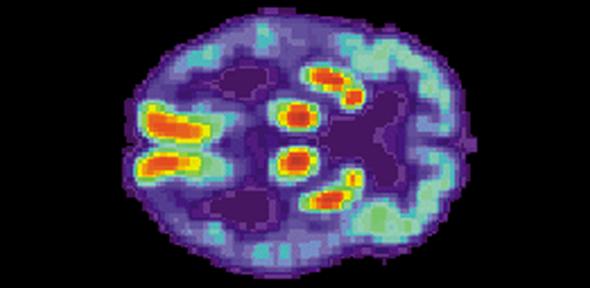
Misfolded proteins build up in the brain in several neurodegenerative diseases and are a major factor in dementias such as Alzheimer’s and Parkinson’s as well as prion diseases. Previously, the team found that the accumulation of misfolded proteins in mice with prion disease over-activates a natural defence mechanism, ‘switching off’ the vital production of new proteins in brain cells. They then found switching protein production back on with an experimental drug halted neurodegeneration. However, the drug tested was toxic to the pancreas and not suitable for testing in humans.
In the latest study, published today in Brain, the team tested 1,040 compounds from the National Institute for Neurological Disorders and Stroke, first in worms (C.elegans) which have a functioning nervous system and are a good experimental model for screening drugs to be used on the nervous system and then in mammalian cells. This revealed a number of suitable candidate compounds that could then be tested in mouse models of prion disease and a form of familial tauopathy (frontotemporal dementia - FTD), both of which had been protected by the experimental - but toxic - compounds in the team’s previous studies.
The researchers identified two drugs that restored protein production rates in mice – trazodone hydrochloride, a licensed antidepressant, and dibenzoylmethane, a compound being trialled as an anti-cancer drug. Both drugs prevented the emergence of signs of brain cell damage in most of the prion-diseased mice and restored memory in the FTD mice. In both mouse models, the drugs reduced brain shrinkage which is a feature of neurodegenerative disease.
Professor Giovanna Mallucci, who led the team from the Medical Research Council’s (MRC) Toxicology Unit in Leicester and is now based at the University of Cambridge, was today announced as one of the five associate directors of the UK Dementia Research Institute. She said: “We know that trazodone is safe to use in humans, so a clinical trial is now possible to test whether the protective effects of the drug we see on brain cells in mice with neurodegeneration also applies to people in the early stages of Alzheimer’s disease and other dementias. We could know in 2-3 years whether this approach can slow down disease progression, which would be a very exciting first step in treating these disorders.
“Interestingly, trazodone has been used to treat the symptoms of patients in later stages of dementia, so we know it is safe for this group. We now need to find out whether giving the drug to patients at an early stage could help arrest or slow down the disease through its effects on this pathway.”
The research was funded by the MRC and Professor Mallucci was also funded by a grant from Alzheimer’s Society and Alzheimer’s Drug Discovery Foundation.
Dr Rob Buckle, Chief Science Officer at the MRC, said: “This study builds on previous work by this team and is a great example of how really innovative discovery science can quite quickly translate into the possibility of real drugs to treat disease.”
Dr Doug Brown, Director of Research and Development at the Alzheimer's Society, said: “We’re excited by the potential of these findings. They show that a treatment approach originally discovered in mice with prion disease might also work to prevent the death of brain cells in some forms of dementia. This research is at a very early stage and has not yet been tested in people - but as one of the drugs is already available as a treatment for depression, the time taken to get from the lab to the pharmacy could be dramatically reduced.”
Reference
Halliday, M et al. Repurposed drugs targeting eIF2α-P-mediated translational repression prevent neurodegeneration in mice. Brain; 20 April 2017; DOI: 10.1093/brain/awx074
Adapted from a press release by the Medical Research Council
A team of scientists who a few years ago identified a major pathway that leads to brain cell death in mice, have now found two drugs that block the pathway and prevent neurodegeneration. The drugs caused minimal side effects in the mice and one is already licensed for use in humans, so is ready for clinical trials.

The text in this work is licensed under a Creative Commons Attribution 4.0 International License. For image use please see separate credits above.